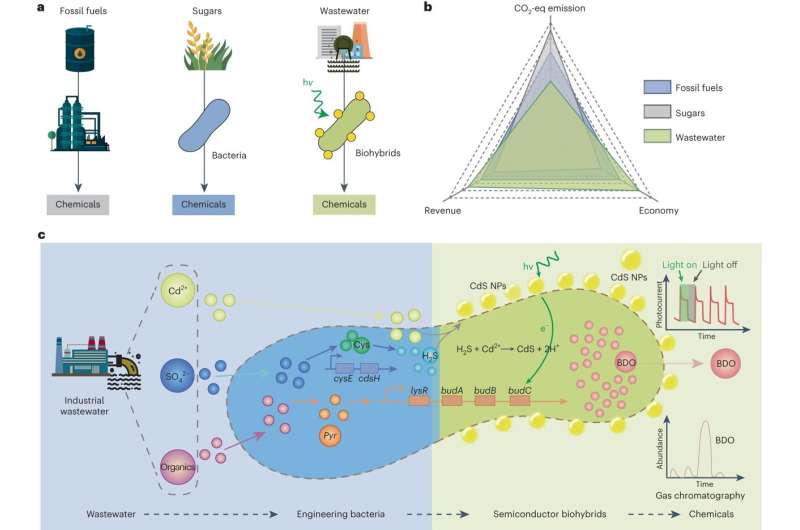This article has been reviewed according to Science X's editorial process and policies. Editors have highlighted the following attributes while ensuring the content's credibility:
fact-checked
peer-reviewed publication
trusted source
proofread
Transforming wastewater into valuable chemicals with sunlight

Researchers led by Prof. Gao Xiang from the Shenzhen Institute of Advanced Technology (SIAT) of the Chinese Academy of Sciences and Prof. Lu Lu from the Harbin Institute of Technology have proposed a novel method to transform wastewater contaminants into valuable chemicals using sunlight, thus paving the way for sustainable and eco-friendly chemical manufacturing.
The study was published in Nature Sustainability.
Conventional chemical manufacturing relies on energy-intensive processes. Semiconductor biohybrids, integrating efficient light-harvesting materials with superior living cells, have emerged as an exciting advancement in utilizing solar energy for chemical production. However, the challenge lies in finding an economically viable and environmentally friendly approach to scale up this technology.
In this study, the researchers set out to convert pollutants from wastewater into semiconductor biohybrids directly in the wastewater environment. The concept involves utilizing the organic carbon, heavy metals, and sulfate compounds present in wastewater as the raw materials for constructing these biohybrids, and subsequently converting them into valuable chemicals.
Nevertheless, real industrial wastewater usually varies in its composition of major organic pollutants, heavy metals, and complex pollutants, all of which are often toxic to bacterial cells and difficult for them to metabolize efficiently. It also contains high levels of salt and dissolved oxygen that require bacteria with an aerobic sulfate reduction capacity. Thus, it's challenging to use wastewater as bacteria feedstock.
To overcome this, the researchers selected a fast-growing marine bacterium, Vibrio natriegens, which has exceptional tolerance for high salt concentration and a capacity for utilizing various carbon sources. They introduced an aerobic sulfate reduction pathway into V. natriegens and trained the engineered strain to utilize different metal and carbon sources in order to produce semiconductor biohybrids directly from such wastewater.
Their primary target chemical for production was 2,3-butanediol (BDO), a valuable commodity chemical.
By engineering a strain of V. natriegens, they generated hydrogen sulfide, which played a pivotal role in facilitating the production of CdS nanoparticles that efficiently absorb light. These nanoparticles, renowned for their biocompatibility, enabled the in-situ creation of semiconductor biohybrids and enabled the non-photosynthetic bacteria to utilize light.
The results showed that these sunlight-activated biohybrids exhibited significantly enhanced BDO production, surpassing yields achievable through bacterial cells alone. Furthermore, the process displayed scalability, achieving solar-driven BDO production on a substantial 5-liter scale using actual wastewater.
"The biohybrid platform not only boasts a lower carbon footprint but also reduces product costs, leading to an overall smaller environmental impact when compared to both traditional bacterial fermentation and fossil fuel-based BDO production methods," said Prof. Gao. "Remarkably, these biohybrids could be produced using a variety of wastewater sources."
More information: Pi, S. et al, Solar-driven waste-to-chemical conversion by wastewater-derived semiconductor biohybrids, Nature Sustainability (2023). DOI: 10.1038/s41893-023-01233-2. www.nature.com/articles/s41893-023-01233-2
Journal information: Nature Sustainability
Provided by Chinese Academy of Sciences





















